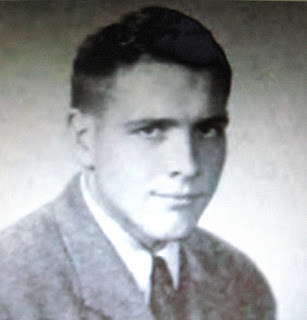William Lance Van Hettinga
 |
| William Lance Van Hettinga (Duke University Yearbook) |
b. 2/8/1938 –
Ann Arbor Michigan
d. 9/18/1989 –
Charleston, South Carolina
William graduated from Duke University in 1963, with
an M.A. in English Literature. His thesis, The Theme of Nonfulfillment in
Three Plays of Clifford Odets", was his parting offering to official Academia.
The following year he took some courses at the Institute
of Theater Arts in Vienna and returned to New York City where he immersed
himself as a denizen of the prevailing “Beat Generation”, finding a niche among
like-minded friends. By 1965, he had begun making avantgarde films and his
first work, Motherlove, was premiered at Film-Makers’ Cinematheque in
1967. The film was a colorful spoof, labeled as “Oedipal Dracula” in theme, and
featured Van Hettinga himself in the role of Dracula’s mother. This was
followed by Happy Birthday Baybee Starr, a satire of an aging film
starlet’s descent into madness, who is finally reduced to writing letters to
her imaginary admirers, signed with her whimsical signature B * (be
a star).
In 1968, William went to Bergen An Zee, the home of
his ancestors, a town on the North Sea coast of Holland. His intention was to re-invent himself and find a
suitable and creative means of self-expression. Reviving his earlier interest
in allegorical emblemata and drawing upon studies of that subject begun at Duke
University and later papers and lectures he had himself produced, he began an
in-depth project to channel his current thoughts and ideas concerning art, writing
and his personal vision into a unique presentation and format, structured
within the framework of concepts traditionally intended for emblems as a moral
compass and inspirational guides.
Inspired by numerous sources and influences, Van Hettinga
garnered new ideas from Edward de Bono, Mario Praz, Teilhard de Chardin and, Jacob Luning Prak. He was also influenced by
studies of Eastern calligraphy, ancient languages and the I Ching, and began
to practice with Sumi inks and brushes and other unconventional writing
materials to evoke a mythical personal script.
It was during this period
he began what he called his first “Non-linear” book, The Grammar of Understanding.
In Holland new friendships
were forged which were to lead Van
Hettinga further into the Arts and also afford him some exhibitions. The most
important of these friendships were with pioneer installation and video artist,
Nan Hoover and Belgian poet, author and artist, Paul de Vree.
In 1974, Van Hettinga exhibited
his work, Visible Language, at the International Cultural Center in Antwerp, Belgium. This elaborate
series was an exercise in his on-going efforts to produce a synthesis of word
and image. The artist’s statement includes some interpretation of his intents…
“the viewer gradually allows his imagination to pass through
the emblem, like a metal plate through acid. The image is animated by an
intense hallucinogenic life inseparable from the page.”
“the struggle between image and word seems to end for me ... then their reflection tends to flow together. The dialog becomes a monologue - the duet, a solo ... to create a calligraphic poem is a meditative act. “
William continued to show his pieces, often in series of ongoing progress for the next few years.
Sins of the Tongue, Diseases of the Will, was his most frequent offering from 1974-77. He also lived in Asheville, North Carolina for a period, yet continued to travel and pursue his career as an artist.
Once again returning to the U.S., Van Hettinga set up a studio in Atlanta. His work from this point on became increasingly esoteric. His most spectacular piece, the Mobius Pheonix, was formed from an entire box of the early style of computer paper with its perforated edges and accordion style folded packaging. Hundred of still intact sheets were joined from the first to the last and twisted to produce a Mobius strip. A nightmare of handling and storing, yet somehow, he managed to cover the pages in his enigmatic calligraphy. Finally, the mixture of the Non-linear and emblematic word-picture was realized.
The Atlanta sojourn was short-lived and Van Hettinga,
after some wandering, moved to Charleston, South Carolina in 1978. After attempts
at creating more emblemata-style projects, he ceased his pursuit altogether.
He began a small
local newspaper, Poor William’s Omnibus which was quite successful.
Essentially a what’s-what, and where-to-go weekly journal of events, social gatherings, gallery openings, restaurants and
other entertainments, all sponsored by local businesses.
This did not prevent him from feeling like an outsider
however, and his psychological condition began to deteriorate rapidly.
Sadly, he did not recover from this strain and in 1989
he died AIDs complications.
"We are mind-trippers and nomads. A heightened consciousness,or perhaps expanded (I almost wrote
its pole: abandoned) consciousness reveals its growth by increased awareness of one's surroundings.
"We are mind-trippers and nomads. A heightened consciousness,or perhaps expanded (I almost wrote
its pole: abandoned) consciousness reveals its growth by increased awareness of one's surroundings.
We are more aware of our journeys and we are becoming more aware that we are strangers. We are tourists in our own cities. And could we but perceive the structures of our communities, we would find them as bizarre as any Arabian city of tents, or as apparently remote as ancient Rome, or as built of myth as Atlantis.”
 |
| Visible Language, at the International Cultural Center in Antwerp, Belgium, 1974 |
 |
| Invitation 1977 |
 |
| Hunter & The Moon Lithograph 1977 |
 |
| Van Hettinga in Studio (from a newspaper article) |
- * In 2020, my portrait of William became part of the Archive of the College of Charleston.
- Thanks to Mr. Harlan Greene for including my offerings to this project.
William Van Hettinga ( 1938-1989) in Amsterdam with his endless Calligraphic poem "The Phoenix" on the original perforated sheets of early computer paper connected as a Möbius Strip.



